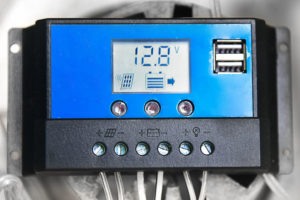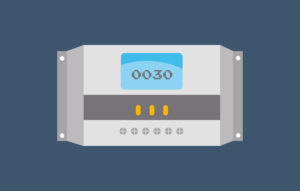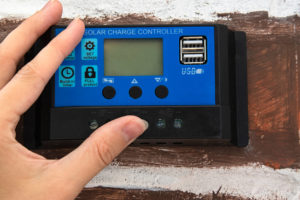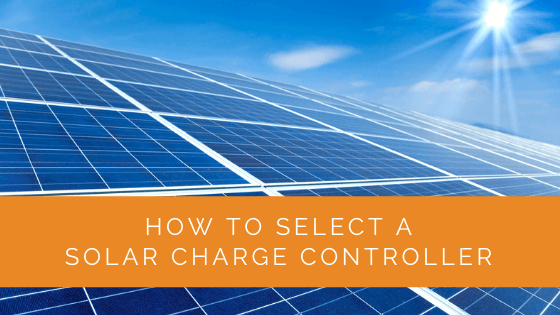Our blog is reader-supported. When you buy through links on our site, we may earn an affiliate commission. Thank you for your support!
Are you looking for a solar charge controller or planning to replace your old one? If you plan to install a solar panel in your home or office, you’ll need a solar charge controller.
This device regulates the entire solar setup and ensures the charging of batteries. So, your controller must be of high quality to run the solar power system and maintain its durability.
Be it an RV or a battery-powered PV setup, a solar charge controller is necessary to regulate the current and voltage.
This article will walk you through all the required pointers to select a solar charge controller.
Contents
- 1 Key Takeaways
- 2 What is a Solar Charge Controller?
- 3 Things to Consider Before Choosing a Solar Charge Controller
- 4 Why will I need Solar Charge Controllers?
- 5 Case Study: Selecting and Implementing the Optimal Solar Charge Controller for a Residential Solar System
- 6 Expert Insights From Our Solar Panel Installers About Selecting a Solar Charge Controller
- 7 Wrap Up
Key Takeaways
- Solar charge controllers are essential for regulating the flow of power in solar panel systems, preventing battery overcharging, and enhancing system longevity.
- There are two main types of solar charge controllers: PWM (Pulse Width Modulation) and MPPT (Maximum Power Point Tracking). The choice between them depends on factors like energy requirements and voltage compatibility.
- Consider factors such as voltage rating, maximum current capacity, temperature, installation process, safety features, and warranty when selecting a solar charge controller to ensure a reliable and efficient solar system.
What is a Solar Charge Controller?
This is a device that works along with your solar panel array and battery. It regulates the amount of power entering in and out of the battery.
The device can be used for all types of solar systems such as PV, utility grids, and hydropower systems.
These devices ensure that the batteries aren’t overcharged during the day. You’ll need to prevent the power from flowing back to the panel array. As this can drain the batteries overnight, the solar charge controllers will stop it too.
How will you know if you need a solar charger? Take a look at the following questions –
- Is your solar-powered system battery operated?
- Do you have an off-grid power plan?
- For every 50 battery amp-hours, does your battery offer 2W of battery charge?
- Is your battery getting overheated and overcharged frequently?
If you answered yes to all the questions above, you need a solar controller. Solving all battery-related problems, the controller will enhance the longevity of your solar system.
Things to Consider Before Choosing a Solar Charge Controller
Now that you’ve wrapped your head around the basics, here are some factors you need to check out. Understanding solar charge controller types, voltage, current capacity, and reliability will help you land on the perfect product in no time.
Let’s dive in!
Types of Solar Charge Controllers
There are mainly two types of controllers – PMW and MPPT controllers.
PWM or Pulse Width Modulation Controllers
They control the energy flow to the battery by regulating the current slowly. The process is called Pulse Width Modulation. So, these devices offer short energy pulses to your solar panel’s battery instead of a steady charge.
A PWM charge controller will keep supplying short bursts of power to keep the batteries fully charged. You can operate it using a switch for your battery and PV array.
During the operation, the battery voltage and solar array voltage will be the same. That’s why a PWM charge controller in small solar homes, RVs, and solar array systems.

MPPT or Maximum Power Point Tracking Controllers
MPPT charge controllers can understand the current and input voltage of the solar array to determine the ideal operating voltage.
This voltage is used to produce the maximum output or power at a given time, a process called maximum power point tracking. So, these devices can utilize the full power of your solar panels and charge the batteries.
Here, the current is pulled at a maximum power voltage. However, an MPPT solar charge controller limits the output voltage of the panel, so the battery isn’t overcharged and damaged.
The MPPT solar charge controller can adjust the input voltage and regulate the current. It enhances the efficiency of the solar panel system.
Energy Requirements
This is a crucial factor for selecting a solar charge controller, no matter how great amazing the device is. You first need to figure out how much energy you have to handle on a daily basis.
For instance, if you want to power up your residence using solar panels, an MPPT solar charge controller will be perfect. It can handle the voltage and current regulations for lighting, heating, and cooking at home.
As an MPPT solar charge controller tackles higher voltage and output current comfortably, it will be ideal for office spaces too. However, RVs or small PV systems will need a PWM solar charge controller.
It’s because PWM controllers work well with a low input voltage, charging handheld devices will be a breeze. You can also light up a few rooms easily with a PWM controller by your side.
Voltage Rating
Most solar charge controllers will have a voltage rating of 12 volt or 24 volts. You’ll find other voltages, but these are most common.
You also have to consider the batteries having 12 and 24 volts of power. So, look for the voltage rating before picking a solar charger controller. Check whether the solar panel system’s charging voltage and battery voltage are compatible with the controller.
This will save you from many technical complications later on and ensure maximum versatility.
Maximum Current Capacity
When you begin your search for solar charge controllers, you’ll notice a variety of current ratings. This actually is an indication of the amount of electrical load the device can handle.
Almost every other solar charge controller supports 10 amp to 20 amp of current. But, if your energy consumption is higher, you can opt for a 30 amp or 40 amp solar charge controller.
This will keep your solar panel safe even if the electric load increases or there is a voltage fluctuation. However, a higher current rating means a higher price, so keep your budget in mind as well.

Temperature
The temperature where your PWM or MPPT charge controller resides is a very crucial factor to consider. A charge controller (PWM) is higher effective in regions having a warm climate, as they are manufactured to work at battery voltage.
On the contrary, MPPT charge controllers are designed for colder climates where the battery voltage is a bit low. No matter where you use the device, you have to keep it protected from harsh weather.
Installation Process
Even if the solar controller is super efficient, tricky installation processes are a nightmare. But, the installation process will depend upon the type and size of the solar charge controller.
So, if you are choosing a PWM controller, you can install it by yourself. These devices are simple and not so sophisticated, so you won’t have a hard time.
For MPPT controllers, you might need additional assistance. As it’s a bit sophisticated, you might need to hire an expert during the installation.
It all depends upon the features you want in your solar controller.
Safety
You can’t ignore the safety factor of any solar charge controller. Most high-quality devices come with safety features, including load overload, short circuit protection, reverse polarity, and overcharging.
These features will keep you and your entire solar panel system safe. A charge controller with a high safety rating also enhances the longevity of your solar system.
Besides all this, if you aren’t sure about using a solar charge controller or any of its features, seek professional help. As accidents do happen while using solar power systems, you better watch out.
Warranty
A solar panel setup usually has excellent durability and runs for years. However, this system can only operate efficiently when all the connected devices are also durable. This includes your solar charge controller too.
That’s why picking a solar charge controller with a decent warranty is essential. It ensures the device’s reliability and durability. A warranty period of 1 to 3 years will be great for all types of users.
If you notice any technical faults within the warranty period, you can easily get the device fixed by the manufacturer. Some products may also offer you the option of extending the warranty by paying an additional amount.
Why will I need Solar Charge Controllers?
You can say that solar charge controllers lay down the foundation of an efficient solar system. It will look after your solar panel array and battery, which will lead to steady lighting.
Let’s have a look at the most important benefits of such controllers.
Battery Overload Protection
In a charge controller, the array current flows through a semiconductor that works as a valve. It controls the current while the charge controller starts its magic! The controller decreases the energy flow to the battery after it reaches a certain voltage.
This prevents the battery from overloading and damaging itself. It also protects the complete solar system.
Suppose your batteries receive a current with an amp higher than what the circuit can handle. It can lead to a voltage overload and overheating.
In such situations, solar charge controllers regulate the energy levels the battery should receive.
Lower Voltage Disconnections
When the battery reaches a low voltage point, the solar controller disconnects the battery from the non-critical loads. It prevents the battery voltage from reaching a stage of over-discharging by controlling the charging voltage.
According to the requirements of the battery, the charge controller will reconnect or switch on the battery back again. This feature helps in protecting the battery and improving its life.

Reverse Current Blockage
A stream of current usually flows from an area of high voltage to low voltage to low voltage. However, sometimes the voltage may flow in the reverse direction and out of the battery.
This happens at night when the solar panels have a low battery voltage. As a result, the battery might suffer a slight discharge.
And this is where a solar charge controller kicks in. It acts as a valve and regulates the charge, preventing any voltage leaks.
Illumination Control
All solar panels absorb sunlight during the day to charge their batteries. This charge is stored and used for lighting up the LEDs at night to brighten up any place!
But did you know solar charge controllers work here too? These devices assist the sensor embedded within the solar panel to switch the system on/off. So, during the day, the lights will be turned off, and they’ll be turned on at night.
Solar charge controllers can help turn the lights on or off at specific periods throughout the day and night.
Displaying Vital Information
Solar charge controllers may also display important data such as solar panel amp, battery voltage, battery bank power level, stage charging data, and temperature.
Case Study: Selecting and Implementing the Optimal Solar Charge Controller for a Residential Solar System
Background
Solar Panels Network USA recently undertook a project to install a residential solar power system. The primary goal was to ensure efficient energy management and maximize the system’s lifespan by selecting and implementing the most suitable solar charge controller.
Project Overview
The project involved a comprehensive assessment of the client’s energy needs, environmental conditions, and the integration of a solar charge controller that would provide optimal performance and durability.
Implementation
- Assessment of Energy Needs:
- Conducted a detailed energy audit to determine the daily energy consumption and peak load requirements of the household.
- Evaluated the client’s preference for a sustainable and efficient solar power solution.
- Selection of the Solar Charge Controller:
- Based on the energy audit, it was determined that an MPPT (Maximum Power Point Tracking) charge controller would be ideal due to its high efficiency in converting solar energy, especially in varying weather conditions.
- Chose a reputable MPPT controller with a voltage rating compatible with the 24V battery system and a current capacity suitable for the solar array’s output.
- Installation and Setup:
- Installed the MPPT charge controller, ensuring proper connections between the solar panels, battery bank, and inverter.
- Configured the controller settings to match the system specifications, optimizing the power conversion and battery charging process.
- Safety and Monitoring:
- Implemented safety features such as overload protection, short circuit prevention, and reverse current blocking to protect the system.
- Set up a monitoring system to track real-time data on solar panel performance, battery voltage, and overall energy output.
Results
The implementation of the MPPT charge controller resulted in several positive outcomes:
- Increased Efficiency: The MPPT controller optimized the power output from the solar panels, resulting in a 15-20% increase in energy efficiency compared to a PWM controller.
- Enhanced Reliability: The system provided a consistent and reliable power supply, even during periods of fluctuating sunlight, ensuring the household’s energy needs were met without interruption.
- Extended Battery Life: The precise regulation of charging and discharging cycles by the MPPT controller helped in maintaining the health and longevity of the battery bank.
- User Satisfaction: The client reported high satisfaction with the system’s performance, noting the significant reduction in electricity bills and the seamless operation of the solar power setup.
Summary
Our project demonstrated the critical importance of selecting the right solar charge controller for optimizing a residential solar power system. By choosing an MPPT charge controller, we ensured enhanced efficiency, reliability, and longevity of the solar setup. At Solar Panels Network USA, we are dedicated to providing tailored solutions that meet our clients’ unique energy needs and promote sustainable living.
Expert Insights From Our Solar Panel Installers About Selecting a Solar Charge Controller
Choosing the right solar charge controller is crucial for the efficiency and longevity of your solar power system. MPPT controllers are ideal for high-energy requirements as they optimize the power output, whereas PWM controllers are more suited for smaller, simpler setups.
Senior Solar Engineer
Consider the environmental conditions when selecting a charge controller. MPPT controllers perform better in colder climates, while PWM controllers are more efficient in warmer regions. This ensures that your system operates at its best regardless of where you are.
Lead Solar Technician
Safety features are a non-negotiable aspect of any solar charge controller. Overload protection, short circuit prevention, and reverse current blocking are essential to safeguard both your batteries and the overall solar setup.
Chief Installation Engineer
Wrap Up
Be it a power point tracking (MPPT) or pulse width modulation (PWM) charge controller, selecting the right one takes time.
Therefore, you need to do your research carefully. Our handy guide will help you at every step of your journey.
If you ever get confused, reach out to the manufacturer or glance at the device manual for more info.
About the Author
Solar Panels Network USA stands at the forefront of solar energy solutions, driven by a team of seasoned solar engineers and energy consultants. With over decades of experience in delivering high-quality solar installations and maintenance, we are committed to promoting sustainable energy through customer-centric, tailored solutions. Our articles reflect this commitment, crafted collaboratively by experts to provide accurate, up-to-date insights into solar technology, ensuring our readers are well-informed and empowered in their solar energy decisions.

